
History of the Project
The Grant Application
The application to the Heritage Lottery Fund itself took 236 hours to prepare, including the detailed costing of every component of each of the projects. This included not only all the foreseeable capital costs, including recording equipment, camera, laptop computer, projector etc but also the running costs and the cost equivalent of the time that the Team estimated they would spend on the work itself. In addition, a large sum was included to buy the village some entrance signs which would illustrate part of Elston’s history. And as the trail would have to be accessible by wheelchairs, the Old Chapel would need a hard surfaced path created across the muddy field that separates it from the edge of the village, and thereby providing an opportunity to solve a long standing problem.
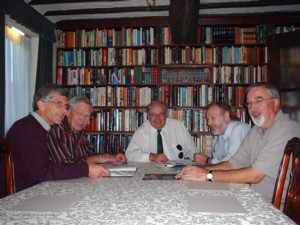
The Steering Group spent several meetings over a period of six months deciding what should go into the application. They are shown here at one of the later meetings discussing the nearly finalised application. Left to right : David Cook, Michael Sergeant, Sam Rabjohn, Dave Sankey, and Stan Firth.
The total estimated cost amounted to £73,000, of which the Pentagon would provide £25,000 in terms of the time the volunteers would spend on the work. The balance of some £48,000, would be met by the Heritage Lottery Fund (HLF). Completed in August 2006, the application was delivered by hand to the HLF’s offices in Nottingham. And early in December 2006 the Pentagon Society was notified that they had been awarded the grant in full. The team were encouraged by the feedback that the HLF scrutineers regarded the application itself as exemplary and one which they would use as a model for others.
As the Pentagon Society’s contribution would be costed at £50 per 7 hour day, records of the time spent by all project members had to be kept from the very beginning. Forms were designed to record telephone calls, mileage, and incidental costs which team members could claim from project funds. Individual budgets were then drawn up for each of the separate projects based on the estimates in the application and allocated to the project leaders.
Launch Event
The Project was officially launched at an open meeting and small exhibition in the Village Hall on 12 March 2007 and was introduced by Cllr Ivor Walker, the Chairman of Newark and Sherwood District Council.
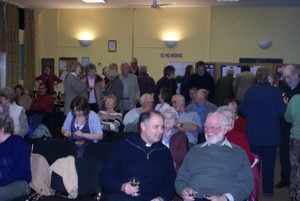 The event was very well attended and generated a great deal of enthusiasm and support for the Project. Visitors were greeted with a drink and sat eagerly waiting to learn what it was all about.
The event was very well attended and generated a great deal of enthusiasm and support for the Project. Visitors were greeted with a drink and sat eagerly waiting to learn what it was all about.
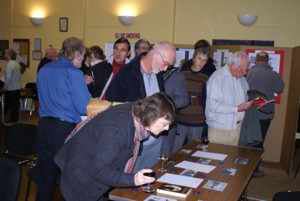 They found a great deal to interest them before and after the presentation by browsing the tables and the display stands which gave a glimpse of what the Project would set out to achieve. They also had a chance to speak to the Steering Group members, to ask questions and to volunteer their help.
They found a great deal to interest them before and after the presentation by browsing the tables and the display stands which gave a glimpse of what the Project would set out to achieve. They also had a chance to speak to the Steering Group members, to ask questions and to volunteer their help.
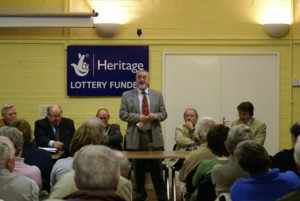 After Cllr Walker’s formal introduction, one by one each member of the Steering Group outlined their part of the Project and appealed for volunteers to help with the work. Here Project Leader Stan Firth addresses the audience flanked by (left to right) Michael Sergeant, Sam Rabjohn, Ivor Walker, Dave Sankey, and Robin Campbell.
After Cllr Walker’s formal introduction, one by one each member of the Steering Group outlined their part of the Project and appealed for volunteers to help with the work. Here Project Leader Stan Firth addresses the audience flanked by (left to right) Michael Sergeant, Sam Rabjohn, Ivor Walker, Dave Sankey, and Robin Campbell.
First Exhibition
Over the weekend of 5th and 6th April 2008, nearly 300 visitors came to see the Project’s first exhibition in Elston Village Hall, dedicated to Harry James, Founder Member and former Chairman of the Pentagon Society, who had died the previous year. On the following Monday morning, the exhibition was kept open especially for the children from the village primary school to view it. The exhibition marked the progress of the first year’s work and comprised 30 themed boards showing photographs of various aspects of village life (church and chapel, work and play, buildings, school, farming, etc).
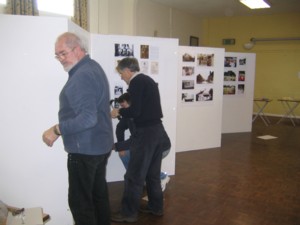 Nottingham Trent University loaned 15 exhibition stands to which were tacked display boards of white vinyl-covered polystyrene sheets with the photographs pinned on with white round headed pins. Jean Williamson printed all of the pictures needed for the display boards with Dave Sankey editing and assembling the final layouts in the last few days before the weekend of the Exhibition. The layout for the Exhibition was two zigzag rows of stands which would be viewed from both sides.
Nottingham Trent University loaned 15 exhibition stands to which were tacked display boards of white vinyl-covered polystyrene sheets with the photographs pinned on with white round headed pins. Jean Williamson printed all of the pictures needed for the display boards with Dave Sankey editing and assembling the final layouts in the last few days before the weekend of the Exhibition. The layout for the Exhibition was two zigzag rows of stands which would be viewed from both sides.
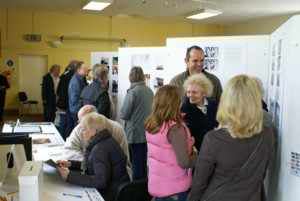
Publicity for the event was in the form of cards left around public venues including Newark Library and the Gilstrap Centre, and A4 posters put up around Elston and in the seven adjacent parishes. Articles were also commissioned in the Newark Advertiser and written for the Octave, the parish magazine.

Visitors were able to browse through eight photograph catalogues containing some 1900 images and ask Richard Brooks or Heather Millard to interrogate the database on a laptop to see if there were any pictures of their ancestors in the Archive. There was also a picture quiz for children and another for the adults.
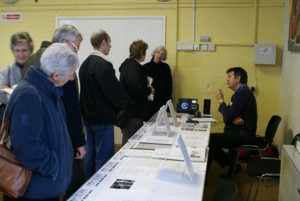
There were tables where visitors could listen to the Oral History project’s first recorded interviews or could buy a limited edition print of David Cook’s painting for the centrepiece of the trail leaflet. Jean Williamson had designed a timeline of events in British history so that visitors could see the parallel events of Elston’s past in context.
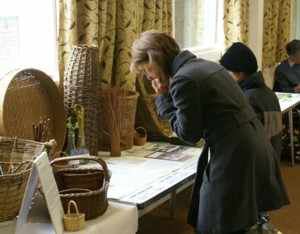 Other boards displayed maps of building changes since 1945 and a schedule of all known demolition and building events back to the earliest known events. Robin Campbell’s Headstone display showed his team’s progress on photographing, deciphering and transcribing inscriptions and on mapping the position of 340 headstones and memorials in the churchyard. Side table displays included the history of basket making in the village and other artefacts.
Other boards displayed maps of building changes since 1945 and a schedule of all known demolition and building events back to the earliest known events. Robin Campbell’s Headstone display showed his team’s progress on photographing, deciphering and transcribing inscriptions and on mapping the position of 340 headstones and memorials in the churchyard. Side table displays included the history of basket making in the village and other artefacts.
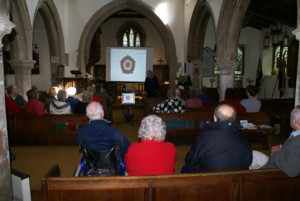
Every two hours in the church, except during the Sunday morning service, Dave Sankey showed two Powerpoint shows – “The Seasons”, a collection of photographs of Elston taken through the year, and “An Elston Walk”, a tour of the village showing old and new pictures to illustrate the changes that had taken place over the years.
The exhibition had 350 visitors and was very well received, judging by the 147 comments in the visitors’ book, all positive or some even effusive. And 23 limited edition prints of David Cook’s artwork were sold. As a result of a suggestion received following the exhibition a binder was put together including the history of the Project and copies of all the exhibition layouts and loaned to people who were unable to attend, including two Elston residents in nursing homes.
Second Exhibition
The second exhibition, held on the weekend of 8th and 9th May 2010 was designed to be significantly different from the first, which had been primarily pictorial. Now the emphasis was more on sound than pictures, though there was plenty to look at as well. There were be ten triangular stands, each one devoted to a different aspect of life in Elston, including farming, trades, social life, the Darwins, Elston Towers etc. The stands each had one or two hand held audio sets that enabled visitors to listen to the voices of some of the oldest Elston residents or those who have lived in Elston a long time, the extracts being taken from interviews carried out over the previous two years. The other two sides of each stand contained photographs relating to the interview extracts and included contextual material to show the social influences on the village through the centuries.
Since the stands occupied a lot of ground space it was necessary to hold part of the exhibition in the church, this being a highly appropriate place for the display by the Church Project. A few relevant display panels from the first exhibition were recycled to supplement the new exhibits. Visitors could learn about the transcribing of all of the 340 graves in the churchyard, and browse catalogues of obituaries, life histories, and photographs on each individual wherever it has been possible to trace them and which also included photos of church memorials and kneelers.
There was also a programme of slide shows in the school hall, including updated versions of the two shown at the first exhibition with a few recently acquired images. There were also three brand new slideshows including an aerial tour of the village, a contemplative guide to the church memorials, and the musical version of the “Then and Now” book called “Elston -- the Musical.”
Project Delay
The decision to dual the A46 and the subsequent public enquiry delayed the project. Until the final route of the new road was determined the second heritage trail to the Stoke battlefield couldn't be finalised. Neither would the Highways Authority give consent for roadside village signs until the road had been in use for a year. Work was also dalayed by the death of one of the volunteers and the serious illness of another. As a result the Heritage Lottery Fund agreed to an extension of the project until the end of July 2010. The prospect of the reopening of an old public right of way, which would improve the planned trail across the Stoke battlefield prevented finalisation of the trail leaflet by July 2010 and a further two months was granted till the end of September 2010.
Permanent Exhibition
As part of the application we had undertaken to put together a permanent exhibition on completion of the Project. We rejected the idea of a display of photos, articles or objects and anything covered with glass to avoid the problems of having to rotate or periodically replace items and the risk of damage to the glass and exhibits. The exhibition therefore took the form of display boards which would be permanent in the sense that they were unchanging but which would be demountable. The logical location was the Village Hall but there were plans to redevelop and enlarge it so any display boards had to be capable of being moved and not to be of so large a size that they would be difficult to resite in say a small meeting room.
There were two display boards ; the first a timeline of the history of Elston and the second a description and commemoration of the Project itself, each on a laminated board three metres wide by one metre deep. They were matching in style, each consisting of 27 vignettes in a chequerboard design of alternating pale green and yellow panels, nine wide by three high.
At the same time the complete results of the Church Project, including data and photographs, were bound into a 700 page ledger, hand stitched and bound in goat skin. This was placed on permanent display in the church, protected by a specially made oak and glass display cabinet.
